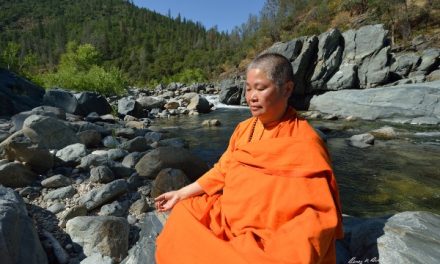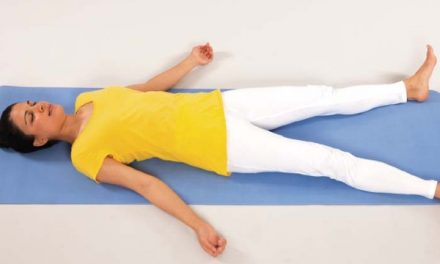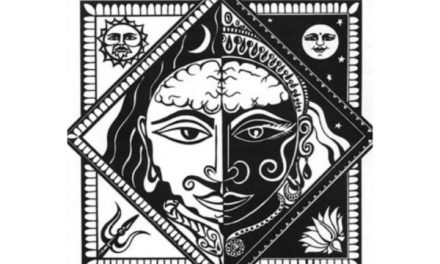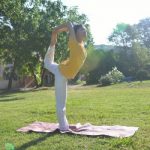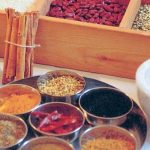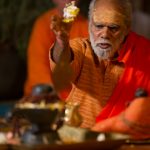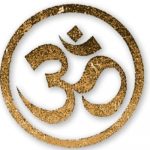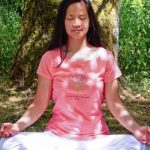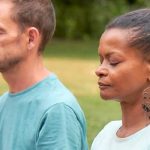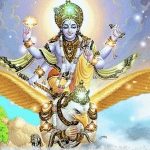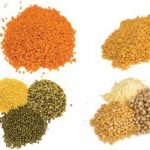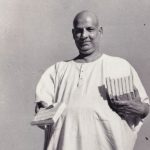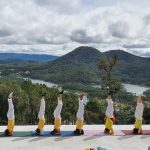 Oxygen – Nerve Impulse – Prana – Thought
Oxygen – Nerve Impulse – Prana – Thought
by Swami Sivadasananda
What do yogis mean by the word prana? Yogis speak about ha and tha, or sun and moon energy, two subtle currents which work within the body. When these energies unite at the level of the solar plexus and ascend along the spine, the mind experiences exhilaration and becomes absorbed in deep meditation. The theory of this subtle process seems to have little to do with the established modern-day understanding of the human body. But before concluding that this theory belongs to the realm of mere belief, here is a closer look at the physiological benefits of hatha yoga breathing exercises.
 Focusing on Inhalation
Focusing on Inhalation
If you are asked to produce a few deep breaths, will you start with inhaling or with exhaling? Most of you will first inhale with the idea that you are “taking a deep breath”. During deep inhalation the action of the diaphragm and the intercostal muscles expands the volume of the lungs, allowing plenty of air to be drawn into the microscopic air bags known as alveoli which make up the spongy tis- sue of the lungs.
These alveoli are surrounded by plenty of capillaries allowing oxygen to move from the lungs into the blood stream and carbon dioxide from the blood into the lungs. This exchange of gases between the air and the blood occurs according to a concentration gradient. If the concentration of oxygen in the lungs is high, more oxygen can move into the blood stream.
However, by putting the emphasis on inhalation instead of exhalation, the lungs are not emptied properly, leaving a substantial volume of old oxygen-poor air in the lungs. Even though a deep inhalation brings in a good amount of oxygen-rich air, it mixes with the remaining oxygen-poor air which is already present. This lowers the oxygen concentration in the lungs. Thus focusing only on inhalation is not an efficient way to bring more oxygen into the blood.
Kapalabhati – Focusing on Exhalation
In the kapalabhati breathing exercise the abdominal muscles are used in a series of short active exhalations, each one followed by a passive inhalation, during which the abdominal muscles are relaxed. This pumping or active emptying and passive filling of a partial volume of the lungs avoids the mixing of fresh and old air. The result is a superior concentration of oxygen in the lungs allowing more oxygen to move into the blood stream.
It takes about ninety seconds for the total volume of blood to make a full round through the body: from the heart to the body tissues, back to the heart, from the heart to the lungs and then back to the heart. When an experienced practitioner does ninety pumpings of kapalabhati at moderate speed, it will take about ninety seconds. During this time the total of the body’s five litres of blood passes through the lungs and receives a superior amount of oxygen.
This is especially invigorating for the brain, which, compared to its size, requires more oxygen than any other part of the body. Kapalabhati is an excellent preparation for meditation and a good stimulant during prolonged mental work. The second phase of kapalabhati consists of two deep breaths using all the respiratory muscles. This prepares the nervous system for the final part of the exercise—the retention of the breath.
Oxygen levels during retention of breath
After the intense exchange of gases during the kapalabhati pumping, the retention begins with a high level of oxygen and a low level of carbon dioxide in the blood. During retention the cells continue to absorb oxygen and expel carbon dioxide, which gradually changes the chemical makeup of the blood. When holding the breath for one minute or even longer, the level of oxygen becomes very low and carbon dioxide very high. This automatically triggers the exhalation.
During the development of the cosmonaut space travel programme in the former Soviet Union, medical researcher Dr Arkadi Prokop studied the impact of high and low levels of oxygen on the metabolism of the cells. Subjects were asked to breathe through a mask connected to a machine producing air of different levels of oxygen concentration. By alternating periods of high and low oxygen, a similar alternation occurred in the blood. The cells themselves also received sometimes more, sometimes less, oxygen.
Breath Retention Rejuvenates the Cells
Microscope observation of the cells showed a surprising change in the mitochondria or ‘power plants’ of the cells. The alternation of oxygen levels resulted in the destruction of old mitochondria and promoted an accelerated reproduction of healthy, younger mitochondria in the cells. This discovery of Dr Prokop was further developed by various university departments of experimental medicine under the name of ‘interval hypoxic training’.
A study at the University of Innsbruck (Austria) reported encouraging improvement in respiratory diseases, high blood pressure and metabolic disorders (greater ease in climbing stairs, less susceptibility to infection, decrease in increased blood pressure, economisation of the heart work, reduction of blood sugar and blood lipids) and on the level of subjective well-being (bad mood, irritability, sadness and lack of motivation), along with improved sleep quality.
Here Swami Sivananda describes one who practises pranayama: He or she will “have a light body free from disease, very fair complexion, a sweet melodious voice, pleasant smell from the body, good appetite, cheerfulness, a handsome figure, good strength, courage, enthusiasm, a high standard of health, vigour, and vitality, and concentration of mind”. One could therefore conclude that the word prana used by the yogis actually refers to certain chemical aspects of the body such as oxygen, carbon dioxide and mitochondrial activity in the cell. But further observations of how pranayama works point to a subtler mechanism.
Pranayama and the Nervous System
Yogic breathing emphasises the use of the diaphragm as the main respiratory muscle. It is controlled by the phrenic nerve which originates in the neck and passes down between the lung and heart to reach the diaphragm. Both inhalation and retention can only happen with the motor impulses of the phrenic nerve causing the contraction of the diaphragm, while exhalation is the result of lowering these impulses and relaxing the diaphragm. An interesting anatomical fact is that the solar plexus (or celiac plexus) receives filaments from the phrenic nerve.
Thus the three aspects of diaphragmatic breathing in pranayama which are inhalation, retention and exhalation, have a specific effect on the solar plexus. The solar plexus is considered an important part of the autonomic nervous system. It relays both sympathetic and parasympathetic impulses, i.e. it has an influence on how well a person reacts to stress and how well he or she can relax. The solar plexus also communicates sensory information from the abdominal area back to the central nervous system.
This is one reason why abdominal breathing is particularly useful to expand body awareness in asanas, pranayama, relaxation and meditation. The connection of the respiratory mechanism with the solar plexus suggests a physiological basis for the affirmation of many yogis: pranayama can produce a conscious or voluntary control of the autonomic or involuntary nervous system. It opens an understanding for the yogic theory that the mind and the functions of the body are connected by prana or life force.
Prana – Vital Energy
Yoga sees vital energy as the central reality of both body and mind. When a person dies the vital energies depart. This is commonly described as the astral body permanently separating from the physical body. All mechanical and chemical therapies can be understood as a variety of ways to improve the balance of vital energy. Until a person dies, various treatments are given to prolong life.
Once a person is dead none would think to inject medicines, apply mechanical therapies or conduct surgery. This supports the yogic view that all life is a manifestation of prana or vital energy. Swami Vishnudevananda used to point out that if the nature of life was merely chemical, then we could supply a person with intravenous feeding and a respiratory mask with unlimited supply of oxygen— and the person would become immortal!
Prana and Thought
The limited idea that the mind is confined to the brain has led to the conclusion that thinking is something individual and therefore limited. But prana not only relates to the physical life of human beings, animals and plants. Thought itself is a manifestation of prana. In the theory of the five elements, the element of space is considered to be the medium of prana. And prana is understood as the medium of thought. Wherever there is space, there is prana and thought. Just as prana affects thought, so also thinking has a powerful influence on prana, and through the prana on the body.
Visualisation in Yoga
Yogis see prana and thought as two sides of the same coin. While practising asanas, pranayama, relaxation and meditation, the power of visualisation can be used to improve the balance of prana in the body for improved health. The efficiency of any visualisation will depend on three factors:
- The power of understanding (jnana shakti): It is prana that you are breathing rather than the atmospheric air. Visualise the inner life energy which underlies the breath and which permeates every atom.
- The power of desire (iccha shakti): Focus on your innermost desire to live, expand, connect and become one with life itself.
- The power of will or action (kriya shakti): Actual experience comes only through practice. Otherwise it will remain wishful thinking. One ounce of practice is better than tons of theory. Develop concentration and will power through yogic discipline.
Become a Yogin and radiate joy, light and power all around you. – Swami Sivananda
Swami Sivadasananda, Yoga Acharya and senior student of Swami Vishnudevananda, teaches workshops throughout the Sivananda Centres in Europe and Teachers’ Training Courses worldwide. email: [email protected]


